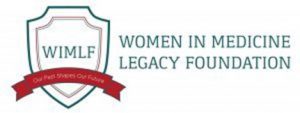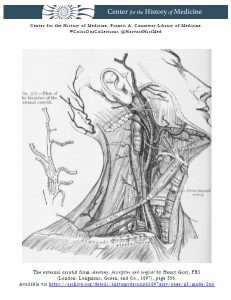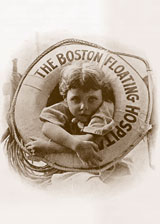Posted by the Center for the History of Medicine by guest blogger Michael P.H. Stanley, MD, Intern, Brigham & Women’s Hospital
On April 8th, 2019, I spent my last day of vacation at the Center for the History of Medicine thumbing an epistolary journey through the communications of surgeon Elliot C. Cutler, hoping to find information pertaining to the neurological activities resulting from Harvard’s manning of WWI Hospital Base No.5 . I was quickly detoured, however, from this duty of delight when in the course of my search I found the story behind one of Cutler’s great works: A festschrift for his beloved mentor, Harvey Cushing.

Harvey Cushing, 1938. Courtesy wellcomeimages.org
Harvey Cushing was born April 8th, 1869 in Cleveland, OH—exactly 150 years from the day I was reading some of his correspondences with Cutler. Cushing received his undergraduate degree at Yale, his medical degree at Harvard, his resident training at Johns Hopkins under the surgeon William Halstead, and his education from his hero, William Osler. He was the first Surgeon-in-Chief of the Peter Bent Brigham Hospital, and one of the fathers of modern neurosurgery, as well as the academic father of countless chairs of surgery throughout the world. An eminent scientist, surgeon, artist, and author, his life is best captured in biographies of Michael Bliss and others, so I will not recount it here. But, on the 150th anniversary of his birth, I will recount a fascinating personal foray of mine into a jubilee publication in dedication to him by Cutler, and in telling it, I aim to capture some of the of enthusiasm and appreciation for this great man.
A festschrift is a celebratory publication in dedication to a figure at an important milestone in his or her life. Elliot Cutler’s idea of such a project occurred to him at the PBBH Decennial Celebration, just a few years before Harvey Cushing would turn 60 years old on April 8th, 1929. This is important because Cushing had been instrumental in a policy at the Brigham in which surgeons would retire at the age of 60. Cushing, fast approaching this deadline, refused to do so, and the conflict between Brigham and Cushing resulted in Cushing leaving Harvard for Yale and bringing with him all his slides, specimens, illustrations, and books. His shift in letterhead over the course of the festschrift materials reflected this. So the very idea of a celebration or memorial piece was already fraught with difficulty because of this sensitive issue. The festschrift was initially planned in secret, but The Chief was quick to ferret out Cutler’s thoughtful machinations about six months into the project, and admonished Cutler that “perhaps [Cutler] might get Williams and Wilkins to publish some of [Cushing’s] occasional addresses as a 60th tribute.” There may be more behind Cushing’s specific substitution. Osler was a hero and mentor to Cushing, and had himself produced a collection, Aequanimitas, containing some of his best occasional speeches. The impulse to follow in Osler’s footsteps and become more available to a lay audience as well as medical no doubt appealed to him. And his request would not go unheeded, as indeed in October 1928 The Atlantic Monthly would bring out a group of Cushing’s nontechnical essays.
However, by the time Cushing heard of Cutler’s efforts, the momentum was not to be stopped. Six months earlier in January 1927, the festschrift was first proposed to Dean Lewis at Johns Hopkins, involved with the Archives of Surgery on behalf of its publisher, the American Medical Association. Cutler envisioned a festschrift unlike most in that it would be limited to Cushing’s pupils alone. “It is our intention that only his pupils join in this work,” Cutler wrote, ”we wish to emphasize the man as a great teacher, which in his own soul is the one great ambition of Cushing’s life.” Admirers and colleagues were to be excluded (or at least, attempted to be). To avoid a sense of entombing Cushing in a retirement or a rustication at Yale, Cutler’s festschrift would reside not as a shelved work, but within a living academic journal. Therefore, Cutler proposed a supplementary fasciculus accompanying the volumes of Archives of Surgery for an entire year, beginning January 1929. Perhaps there would be 50 contributors and maybe one-thousand pages total, he suggested. Like any good salesman, he stressed the serious contribution Cushing has made to surgery throughout the world, and how having such a fasciculus could pay for itself with the advertisements included, and how it would broaden the journal’s circulation with newly interested readers.
Lewis replied favorably to the proposal, but suggested instead of serialization to have just one large fasciculus, and that the January deadline might be too hopeful, whereas rolling it back to April would place it nearer Cushing’s birthday. Lewis said, “I shall be very glad to receive your manuscript when you have it ready. You [Cutler] can edit the volume yourself, putting them in any way you wish, and take charge of it.” He also warned that the project would be expensive, and that Cutler and his informal committee, should be prepared to fund half of the expense. At the time the estimate was $1250. Cutler then began soliciting quietly for articles and for small donations, as he did not want The Chief to know of this effort (although as indicated above, within six months time Cushing was very much aware of this activity, and would make several intercessions to break up fights and fussing between bruised egos like William T. Bovie and A.J. McLean). The authorship read like a pantheon of surgical and pathological luminaries: Wilder Penfield, Stanley Cobb, Tracy Jackson Putnam, Walter Dandy, Arthur Earl Walker, to name a few. This list of Cushing’s disciples renovated every conceivable discipline, and here was their latest work bundled up as show of gratitude. This was itself a testament to Cushing’s influence. A bibliography and even a list of Cushing’s many accolades would not appear in the work—there simply was no room for it all. Cutler sent continual reminders to Lewis about the project, but never received an official confirmation of approval until June 4th, 1928, in which Lewis places Cutler in touch with Morris Fishbein the supervising official of the American Medical Association’s publications. For the next two years, Cutler and Fishbein would collaborate on this labor, often suffering the abuses of critical authors, at other times soothing egos between authors still vying for precedence, and shouldering various financial and production difficulties. Cutler’s festschrift and the primary literature surrounding it within the CMH archives is an education in the hazards of publication.
It was decided the volume would not be a supplement, but would be a stand-alone volume. The articles would be arranged in chronological order not by discovery of the topic discussed, but in order of each author’s tutelage under Cushing. This was suggested cleverly by Fishbein, which Cutler recognized, as it “obviously place[d] your most important papers out front, and at the same time will not give offense to brilliant young pupils.” The dedication page vacillated between English and Latin translations (Cutler would consult the Ohio State University’s Latin department on the accuracy of his rendering), but eventually would be published with Latin dedication in a special, limited edition, and English for the general circulation: Chirugo clarissimo optimoque magistro (translated tersely as “Master Surgeon and Teacher”). Fishbein invited Cutler to send the manuscripts along as they were finished for proofing in order to avoid a log-jamming in February. This was wise because the authorship ballooned from a proposed 50 to over 80 contributors, and indeed the book was not finalized until the last possible moment, roughly ten days before its printing. Indeed, a telegram from Cutler to Fishbein read simply, “Where is the book? – Cutler” as late as April 2nd, 1929.
They grossly underestimated the time and expense. The work would stand with greater than 80 contributors, swell to over eleven-hundred pages, and cost $10-12,000 when completed with illustrations. Cutler would have to continue a separate philanthropic campaign for the book that would trail on until at least 1930 to meet the $5000 share promised. These would be made of small donations from the contributors themselves, their families, and the friends and loved ones of Cushing. It was presented to Cushing on April 6th at a special celebration at the surgical laboratory at PBBH, but his birthday would be celebrated at Johns Hopkins. In a thank-you to AMA editor-in-chief Fishbein, Cushing wrote:
“I am simply bowled over, flabbergasted, dumfounded, by that Birthday Book you have seen fit to publish. I suppose you must have thought: Now the only way to get rid of, to wholly and effectually eliminate, that pestiferous Cushing who behaves as though he was in the Manor (Boston) born but wasn’t, is to allow his cubs to get out this book after which the only decent thing he can do is to resign and I’ll no longer be troubled by his hyphen, dyphthongs [sic], PBBH surgical numbers, and other crochets. But then I may forget about it – that I am 60 – and may scribble some more, proceeding backward down hill like the squid leaving behind me my customary trail of ink (I suppose a squid can go down hill under water- or there may be land squids: in fact I’ve met some examples in the life.) Anyhow, I am much beholden to you for the trouble you must have tearing of hair in the process.”
Cushing could estimate the onerous task of monument-making, and in fact both Cutler and Fishbein suffered personally in disgruntled friends, sometimes neglected family duties, and postponed mourning of calamities (Fishbein’s son died of rheumatic fever shortly before the festschrift was published).
One of the last features of the text to be selected was the photograph of Harvey Cushing. Out many solicited, stern and imposing, in February of 1929 the chosen image was a candid taken by one of Cushing’s interns because “the informality of the subject is the happy thing about it.”
Cutler’s own contribution to the work, an historical piece entitled, The Art of Surgery, offers the lapidary statement: Science teaches us to know, and an art to do. He wanted to relate surgery, a manual field of action for centuries looked down by ‘practitioners of physick,’ and remind his contemporaries of the powerful art that changed and saved lives every day, with Cushing at its zenith. The articles written by leading lights contained within the festschrift are a portfolio of sweat and work, not postulation and posturing. It was, therefore, a fitting tribute to Cushing, himself an artist with pen and scalpel equally adroit. I spent Cushing’s 150th birthday following the story of this jubilee festschrift stewarded by Cutler. Along the way there were many personalities, lovely phrases, course and quaint handwriting, but more than anything it was the little off-hand comments, asides, and jokes amongst friends and colleagues that sketched for me characters hitherto recognized as anything other than words on walls of wards. It is my hope that during this year we may consider our own history of our histories, and I choose to concentrate on Cushing. If science is to know, and art is to do, then history might be knowing how it was done.










